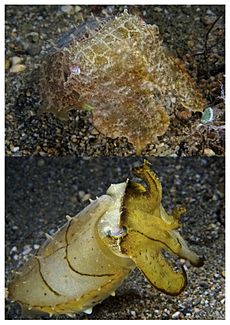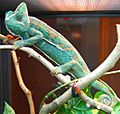Chromatophore facts for kids
Chromatophores are special cells that hold pigment (color) or reflect light. You can find them in animals like amphibians (frogs), fish, reptiles (lizards), crustaceans (crabs), and cephalopods (octopuses). These cells are mostly in charge of making the skin and eye colors for cold-blooded animals.
Some animals can change their color very quickly. They do this to hide from predators or prey, which is called camouflage. They also use color changes to send signals to other animals. They make these changes by moving the pigment and reflective parts inside their chromatophore cells. This quick color change is called physiological color change.
Animals like octopuses have amazing chromatophore organs. These organs are controlled by muscles, letting them change color super fast. Their brain controls these displays, often based on what their eyes see.
Vertebrates, like chameleons, also change color. They use special signals within their cells to do this. These signals can be hormones or chemicals called neurotransmitters. Changes in their mood, temperature, stress, or what they see around them can start these color changes.
How Cephalopods Change Color
Cephalopods like squid, cuttlefish, and octopuses have very complex organs for changing color. Each chromatophore unit has a single chromatophore cell, plus muscle, nerve, and other helper cells. Inside the chromatophore cell, the color pigments are held in a stretchy sac.
To change color, the animal uses muscles to change the shape or size of this sac. This makes the color look different. This is a unique way to change color. Fish, amphibians, and reptiles move pigment around inside their cells. But cephalopods change the shape of the whole pigment sac. Both ways achieve a similar amazing effect.
Octopuses can make their chromatophores work in cool, wavy patterns. This creates quickly changing color displays. The nerves that control these chromatophores are thought to be arranged in the brain in a similar way to the chromatophores themselves. This might explain why the color changes happen in waves as the nerve cells activate one after another.
Like chameleons, cephalopods use color changes to talk to each other. They are also masters of camouflage. They can match both the color and the texture of their surroundings with incredible accuracy.
Images for kids
-
Chromatophores in the skin of a squid
-
A veiled chameleon, Chamaeleo calyptratus. Its green and blue colors come from different chromatophore types reflecting filtered light.
-
At the bottom, a mutant zebrafish larva that can't make melanin in its melanophores. At the top, a normal, wildtype larva.
-
The purple-striped dottyback, Pseudochromis diadema, makes its violet stripe with a special type of chromatophore.
-
A single zebrafish melanophore seen over time as its pigment gathers.
-
Zebrafish chromatophores help them blend in with dark (top) and light (bottom) backgrounds.
-
An infant cuttlefish, using background adaptation to copy its surroundings.
See also
 In Spanish: Cromatóforo para niños
In Spanish: Cromatóforo para niños









